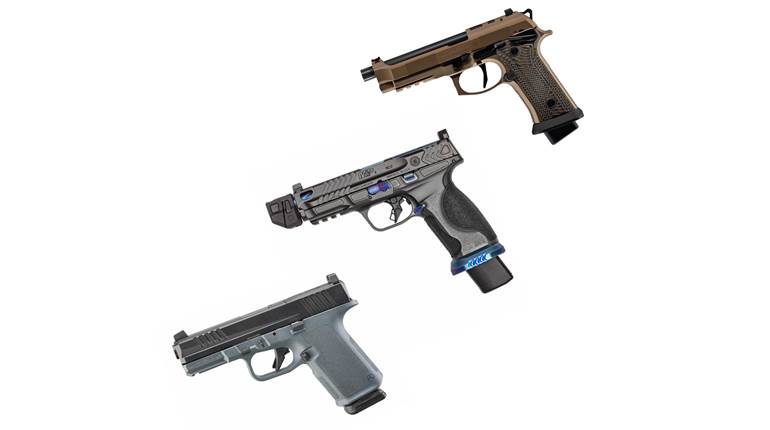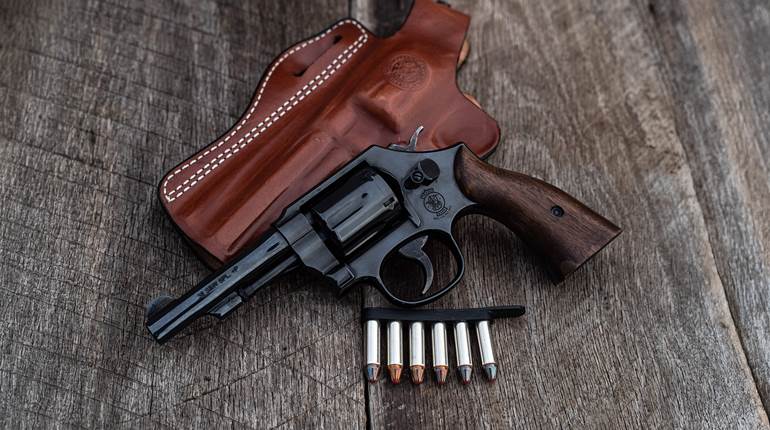
As wars end, the people may rejoice, but manufacturers—especially gun manufacturers—often weep, wring their hands and rend their clothes. From 1942 until the middle of 1945 U.S. manufacturing operated at a feverish pace to support the efforts of the military in Europe and the Pacific. Firearms manufacturers are often the first that must instantly switch from a peacetime civilian market to a wartime military market.
Springfield Armory could not keep up with the demands of M1 Garand rifles, and companies like Winchester, Harrington and Richardson, International Harvester and Beretta had to be pressed into service to fill the gap. It was the same for Colt and the demand for 1911 pistols. Remington Rand, Union Switch & Signal, Ithaca and even the Singer Sewing Machine Co. had to answer the call for the war effort. The ability of these companies to switch their manufacturing facilities as suddenly as if they were hit with a cattle prod, retool and start manufacturing guns is a remarkable and fascinating sidebar of American history. And so it was similarly when the war wound down to zero in just a few months—from about April through August of 1945—demand for manufactured firearms dropped to zero as well. Colt went from making more than 30,000 copies of the 1911 each month in early 1945 to zero during that four-month period. That’s hard on the bottom line and even more difficult to keep employees working. From the latter part of 1945 through 1947 virtually no new guns left the factory. Many longtime employees retired, taking the skills they had acquired with them. Because of this and a gross mismanagement of revenues during the war, once again, the then-92-year-old company was staring bankruptcy in the face. Almost like a drunk attempting to sober up after a bender, Colt desperately tried to rekindle its civilian firearms’ market—a market the company has historically only reluctantly tolerated to get it through the tough times between armed conflicts.
Meanwhile, archrival Smith & Wesson some 31 miles due north had continued its nurturing of civilian gun sales. In the depths of The Depression S&W had brought out the .357 Mag. revolver—later to be called the Model 27. Those first .357s were hand assembled, magnificent examples of gunmaking—so much so that the first ones were registered to owners through the company. The gun and the cartridge rapidly drew an eager following of law enforcement folks, outdoorsmen, hunters and even target shooters. Colt was caught with its pants down.
By September 1955 Colt’s board of directors merged the company with Penn-Texas, a relatively new company that had acquired Pratt & Whitney, a tool-making company that also makes rifling machines for firearms manufacturers. Colt also introduced a very high-end rendition of its I-frame .357 Mag. revolver brought out in 1953, calling it the Colt Python. The I-frame was a slightly enlarged and heat-treated modernization of the company’s E-frame Army Special of 1908. Like its northern competitor, the Python was from the get-go a premium revolver, and it looked the part. The first thing one noticed was the barrel with an integral ventilated rib and a full-length underlug. Stocks were a select grade of walnut in a hand-filling, target-stock profile with a generous amount of checkering and without varnish. Sights were, of course, fully adjustable. Metal finishes were either a Colt Royal Blue—arguably the finest ever seen on a factory production firearm—or a bright nickel plate. Later the nickel plating was discontinued when Colt figured out how to give an almost equal glimmer to the more durable stainless steel.
While vent ribs, underlugs and a high polish may have lured a lot of guys to the Python, it was the revolver’s superb trigger pull and accuracy that swooned real shooters. Single-action pulls came from the factory ready to go to the target line, and the double-action pulls were every bit as smooth as the Registered Magnums from S&W. Some felt the Colt’s DA pull was even better due to its V-shaped mainspring that seems to stack—or gain resistance—less than a single leaf-type spring found on the S&Ws. Nonetheless, the Python was one of the finest double-action revolvers ever produced.
The first Pythons had hollow underlugs, but that feature was quickly jettisoned in favor of more barrel weight to control recoil in hotter loads. Barrel lengths ran from 2 1/2", 3" (a very rare length sometimes called the Combat Python), 4", 6" and 8". A few other chamberings were offered—.256 Win. Mag., .38 S&W Spl., .41 Mag. and .44 Spl., but these are also quite rare. Collectors should be very wary of fakes.
From 1955 until 1969 Python serial numbers had no letter prefix or suffix, and these are the most sought after by collectors. In 1983 the revolver was offered in stainless steel—both matte and high-polish—and featured neoprene stocks. The 2 1/2" stainless was discontinued in 1994, and an 8" stainless was added in 1989. Several other limited runs were brought to market until 1996 when the Python was dropped from regular production. It remained available through Colt’s Custom Shop until 2005.
The Python was at one time an issued revolver to the Colorado State Highway Patrol, Florida Highway Patrol and the Georgia State Patrol. Like virtually all law enforcement agencies, though, they sent the revolvers packing when the tidal-wave trend of semi-automatic pistols came into vogue. Today the Python has achieved a sort of mega-status as a collectable revolver. Back when I started buying guns in the early ’70s Pythons were in nearly every gun store with a price tag of $275 to $300, if memory serves. I wish I’d bought everyone I saw. Today those guns would fetch well into four figures if they are in pristine shape. Some of this is due to the use of the revolver in the television series “The Walking Dead.” Much like the fanaticism of the S&W Model 29 after the film “Dirty Harry,” people who know little about shooting but are desperate to look cool clamor to own a gun like the one they see on screen, thus driving up the prices. If you are fortunate to have one or two and are willing to part with them, this is probably a good thing. However, if you are a shooter who desires to own and shoot a quality piece, maybe it’s not such a good deal.






































